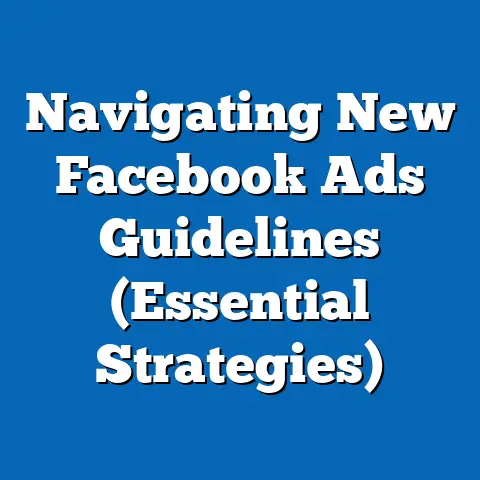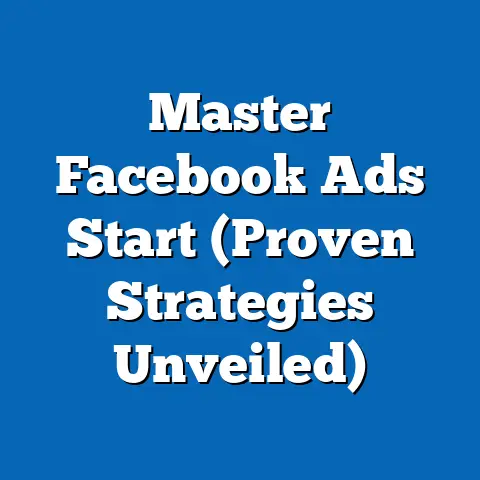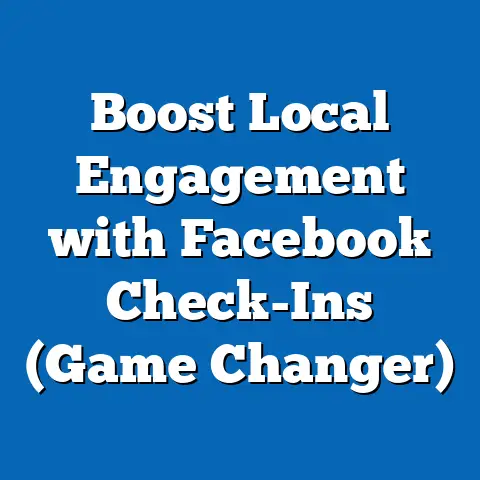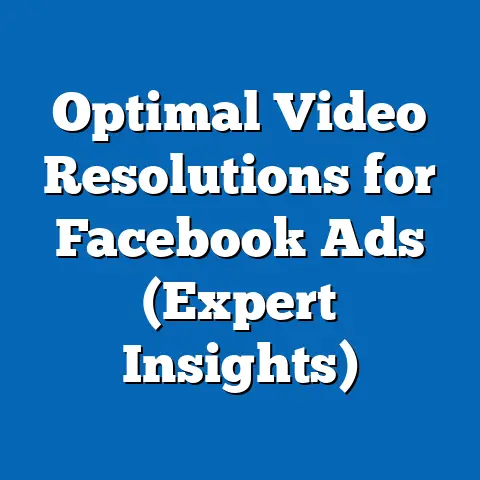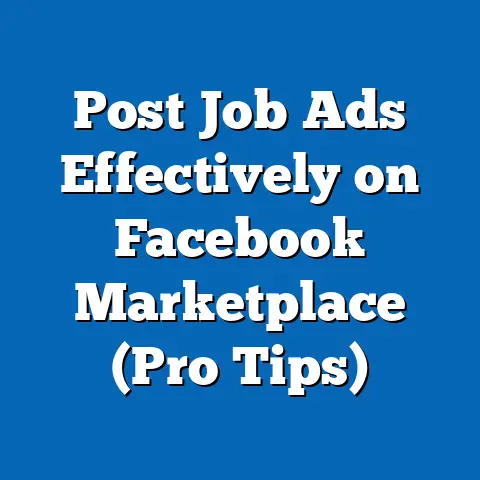Essential Facebook Ad Checklist (Ultimate Success Blueprint)
Advertising has come a long way, hasn’t it? I remember when businesses primarily relied on print ads in newspapers and magazines, or radio commercials to reach their audiences. These methods, while effective for their time, lacked the precision and real-time feedback we now take for granted. Fast forward to today, and social media platforms like Facebook have revolutionized how we connect with potential customers.
Facebook advertising stands out because it allows us to target specific demographics, interests, and behaviors with unparalleled accuracy. We can measure campaign success in real-time, tweaking our strategies on the fly to maximize our return on investment (ROI). But with so many options and features, it’s easy to feel overwhelmed. That’s why I’ve created this comprehensive checklist. Think of it as your go-to guide for creating effective Facebook ads that resonate with your target audience and drive measurable results. Let’s dive in!
1: Understanding Your Audience
Before you even think about crafting an ad, you need to know who you’re talking to. It’s like trying to hit a target in the dark – you might get lucky, but your chances of success are slim. Defining your target audience is crucial for ensuring your ads reach the right people, at the right time, with the right message.
So, how do you pinpoint your ideal customer? Start by delving into audience research. Facebook Audience Insights (though it’s been replaced by Meta Business Suite Insights, the principle remains the same) is a fantastic tool for gathering data on demographics, interests, behaviors, and more. I’ve personally used it to uncover surprising insights about my audience, like unexpected interests that I could then target with specific ad campaigns.
Beyond Facebook’s tools, consider conducting surveys, analyzing your existing customer data, and studying industry reports. The more you know about your audience – their pain points, desires, and online habits – the better you can tailor your ad content to meet their needs and preferences. For instance, if you’re selling eco-friendly products, you’ll want to target users who are interested in sustainability, environmental causes, or organic living.
Key Takeaway: Thorough audience research is the foundation of any successful Facebook ad campaign. Don’t skip this step!
2: Setting Clear Objectives
Once you know who you’re targeting, it’s time to define what you want to achieve. What’s the purpose of your Facebook ad campaign? Are you looking to increase brand awareness, generate leads, drive website traffic, or boost sales? Having clear objectives is essential for measuring your success and optimizing your campaigns.
I always recommend using the SMART goals framework:
- Specific: Clearly define what you want to achieve. Instead of saying “increase brand awareness,” try “increase brand awareness among women aged 25-34 in the United States.”
- Measurable: How will you track your progress? What metrics will you use to determine if you’ve reached your goal? For example, “increase website traffic by 20%.”
- Achievable: Is your goal realistic? Consider your budget, resources, and historical performance.
- Relevant: Does your goal align with your overall business objectives?
- Time-bound: When do you want to achieve your goal? Set a deadline to create a sense of urgency.
Here are some common objectives for Facebook ads:
- Brand Awareness: Reach a broad audience and increase recognition of your brand.
- Lead Generation: Collect contact information from potential customers.
- Website Traffic: Drive visitors to your website.
- Engagement: Encourage likes, comments, shares, and other interactions with your content.
- Conversions: Drive sales, sign-ups, or other desired actions on your website.
Key Takeaway: Define your objectives using the SMART framework to ensure they are clear, measurable, and achievable.
3: Crafting Compelling Ad Copy
Now for the words! Your ad copy is what will capture your audience’s attention and persuade them to take action. It needs to be clear, concise, and compelling.
Here are the key elements of effective ad copy:
- Attention-grabbing headline: Your headline is the first thing people will see, so make it count. Use strong verbs, numbers, or questions to pique their interest.
- Clear messaging: Explain what your product or service is and how it will benefit your audience. Focus on the value you offer, not just the features.
- Strong call-to-action (CTA): Tell people exactly what you want them to do. Use clear and concise CTAs like “Shop Now,” “Learn More,” or “Sign Up Today.”
Your ad copy should also align with your audience’s pain points and desires. What problems are they facing? What are they hoping to achieve? Address these issues directly in your copy to show that you understand their needs.
Persuasive language and emotional triggers can also enhance ad effectiveness. Use words that evoke positive emotions, such as “exciting,” “transformative,” or “life-changing.” Consider using social proof, such as testimonials or reviews, to build trust and credibility.
Key Takeaway: Craft compelling ad copy that grabs attention, clearly communicates your value proposition, and includes a strong call-to-action.
4: Designing Engaging Visuals
In the fast-paced world of social media, visuals are king. Compelling images or videos can significantly enhance engagement rates and make your ads stand out in the crowded newsfeed.
Here are some best practices for selecting or creating visuals:
- Branding consistency: Use colors, fonts, and imagery that align with your brand identity.
- High-quality imagery: Use professional-quality photos or videos that are clear, well-lit, and visually appealing.
- Relevance to the ad copy: Make sure your visuals are relevant to the message you’re conveying in your ad copy.
- Mobile optimization: Ensure your visuals look good on mobile devices, as most Facebook users access the platform on their phones.
I’ve found that testing different visual formats can also be highly effective. Carousel ads, which allow you to showcase multiple images or videos in a single ad, can be great for highlighting different features of your product or service. Video ads are particularly engaging and can be used to tell a story or demonstrate how your product works.
Key Takeaway: Invest in high-quality, engaging visuals that are relevant to your ad copy and optimized for mobile devices.
5: Choosing the Right Ad Format
Facebook offers a variety of ad formats to choose from, each with its own unique advantages and potential use cases. Understanding these formats and selecting the right one for your campaign goals is crucial for maximizing your results.
Here’s a quick overview of some of the most popular Facebook ad formats:
- Image Ads: Simple and effective for showcasing a single product or service.
- Video Ads: Highly engaging and ideal for telling a story or demonstrating how your product works.
- Carousel Ads: Allow you to showcase multiple images or videos in a single ad, perfect for highlighting different features or products.
- Collection Ads: Designed for e-commerce businesses, these ads allow users to browse and purchase products directly from the ad.
- Lead Ads: Collect contact information from potential customers without requiring them to leave Facebook.
- Instant Experience Ads: Full-screen, mobile-optimized ads that provide an immersive experience for users.
When choosing an ad format, consider your campaign goals, target audience, and budget. Experiment with multiple ad formats to see what resonates best with your audience and delivers the best results. For example, if you’re trying to generate leads, a lead ad might be the most effective format. If you’re trying to drive sales for an e-commerce store, a collection ad might be a better choice.
Key Takeaway: Familiarize yourself with the different Facebook ad formats and choose the one that best aligns with your campaign goals and target audience.
6: Budgeting and Bidding Strategies
Setting a budget for your Facebook ads is essential for controlling your spending and ensuring you get the best possible ROI. Your budget will impact your campaign reach and frequency, so it’s important to allocate your resources effectively.
Facebook offers two main types of budgets:
- Daily Budget: The average amount you’re willing to spend each day.
- Lifetime Budget: The total amount you’re willing to spend over the entire duration of your campaign.
Within Facebook Ads Manager, you’ll also find different bidding strategies to choose from. These strategies determine how Facebook will bid on ad placements on your behalf. Some common bidding strategies include:
- Cost-Per-Click (CPC): You pay each time someone clicks on your ad.
- Cost-Per-Impression (CPM): You pay for every 1,000 impressions your ad receives.
- Cost-Per-Action (CPA): You pay only when someone takes a specific action, such as making a purchase or signing up for a newsletter.
When choosing a bidding strategy, consider your campaign goals and budget. If you’re focused on driving traffic to your website, CPC might be the best option. If you’re focused on brand awareness, CPM might be more effective. CPA is generally the most expensive option, but it can be a good choice if you’re confident that your ads will drive conversions.
Allocating your budget effectively across different campaigns and ad sets is also crucial. Consider using A/B testing to determine which ad sets are performing best and allocate more of your budget to those.
Key Takeaway: Set a budget that aligns with your campaign goals and choose a bidding strategy that maximizes your ROI.
7: Tracking and Analyzing Performance
Tracking key performance indicators (KPIs) is essential for measuring the success of your Facebook ad campaigns and making data-driven adjustments. Without tracking your performance, you’re essentially flying blind.
Here are some essential metrics to monitor:
- Click-Through Rate (CTR): The percentage of people who see your ad and click on it. A high CTR indicates that your ad is relevant and engaging.
- Conversion Rate: The percentage of people who click on your ad and then take a desired action on your website, such as making a purchase or signing up for a newsletter.
- Cost-Per-Click (CPC): The amount you pay each time someone clicks on your ad.
- Cost-Per-Conversion (CPC): The amount you pay for each conversion.
- Return on Ad Spend (ROAS): The amount of revenue you generate for every dollar you spend on advertising.
Facebook Ads Manager provides a wealth of data and analytics tools to help you track your campaign performance. You can use these tools to analyze your results, identify areas for improvement, and make data-driven adjustments to your campaigns.
I often use custom dashboards within Facebook Ads Manager to track the metrics that are most important to my business. This allows me to quickly see how my campaigns are performing and identify any potential issues.
Key Takeaway: Track your KPIs regularly and use data-driven insights to optimize your Facebook ad campaigns for maximum performance.
Conclusion
So there you have it – the essential Facebook ad checklist! By following these steps, you can significantly enhance your chances of creating successful campaigns that achieve your marketing goals. Remember, Facebook advertising is an ongoing process of experimentation and optimization. Don’t be afraid to try new things, test different strategies, and continuously iterate based on your performance data.
Staying updated with Facebook’s evolving ad features and trends is also crucial for maintaining a competitive edge in the digital advertising landscape. Facebook is constantly rolling out new features and tools, so it’s important to stay informed and adapt your strategies accordingly.
By implementing the strategies outlined in this checklist and staying up-to-date with the latest trends, you can unlock the full potential of Facebook advertising and achieve your business goals. Now go out there and create some amazing ads!

